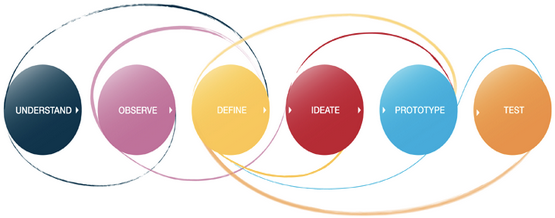In the relatively young and growing field of UX, buzzwords are constantly coming into trend and, just as fast, expiring. “Design Thinking,” the latest buzzword to describe UX processes’ integration with product development, has replaced “User Centered Design,” which employs nearly the same best practices. Though the two mean virtually the same thing, every firm or corporation is now frantically employing “Design Thinking” in its product development process.
Regardless of what term you choose to describe it, this set of practices and processes is influencing the roles and titles of UX professionals. At the advent of the UX field, there were researchers and designers, two distinctive roles that allow those specializing in each to fully commit to their craft. However, with the 'Design Thinking' movement, the lines between the two roles are blurred. More and more, researchers are doing design, and designers doing research. Design Thinking practices and UCD processes further promote the combined role, as they call for frequent contact with users to ground design. Instead of handing off research projects to researchers, which would require ramp-up time and potentially longer turnaround time, designers who conduct their own research can do so at a quicker pace. Since designers know their own projects, there is virtually no ramp-up required, and the resulting process becomes more “agile.” Conversely, researchers who can illustrate their design recommendations through wireframing and rendering from powerpoint would cut out the need for designers to familiarize themselves with research findings and user needs before beginning the design process. Overall, the hand-off/ramp-up time required for collaboration between the two roles could be eliminated.
Design Thinking Process

Research Research Research Design Design Research
(
Source)
It's no wonder that UX generalists are making more appearances these days in companies and firms. Not only does the UCD process goes quicker, employers are getting a “2 for 1 deal.” It's rare to find a pure UX researcher or designer these days.
Though this combined role seems like the “magic unicorn,” one has to wonder whether UX generalists are really good at any one craft. Research and design require very different skills that don't often overlap, though the content is usually the same. For instance, a website redesign project may require up-front research to gain insight into user behaviors, followed by proposed designs, and end with design validation. Though the heart of the project — the e-commerce site — is the same for both research and design processes, each phase requires different skills. During the research phase, one must be objective and unbiased while getting feedback on designs they had created. In the design phase, a researcher can’t get too bogged down with user findings that may restrict creativity.
Is it easy enough for researchers to put on designer hats, to allow themselves full creativity without being distracted by usability issues that aren’t relevant yet? Can designers put on their researcher hats and remain impersonal to feedback on designs they had just created? Are we being too lax with combining these roles? More importantly, is the quality of the results compromised as researchers and designers juggle different skill sets?
Here are some observations from my experience juggling both roles in maintaining quality results from each phase:
- Doing both research and design is do-able as long as you allocate the proper time to each phase
- When you research, try to leave your design hat at the door, and vice versa. This is harder than you think, as it’s always easy to get caught up coming up with solutions while participants point out usability issues. Conversely, a designer may lean towards designing with usability issues only in mind, forgetting other factors driving the design.
- Ethnographic, early-inception research requires more time and deserves the full attention of a researcher. In other words, researchers must fully don their researcher hats at this point and forget about design.
- The design process is on-going, and knowing how and when to integrate user findings is a skill that’s gained from experience.
- Design validation can be done quickly but requires objectivity during moderation. How the findings influence the design depends on the designers’ ability to focus on the findings that are significant enough, as opposed to others that may be outliers or not relevant to the design.
Combining the roles can be done — but combining the work into one muddled research-and-design effort is less than ideal.
Respecting each craft as its own, and providing enough time and mental space for each phase, increases the chances of producing high quality results.